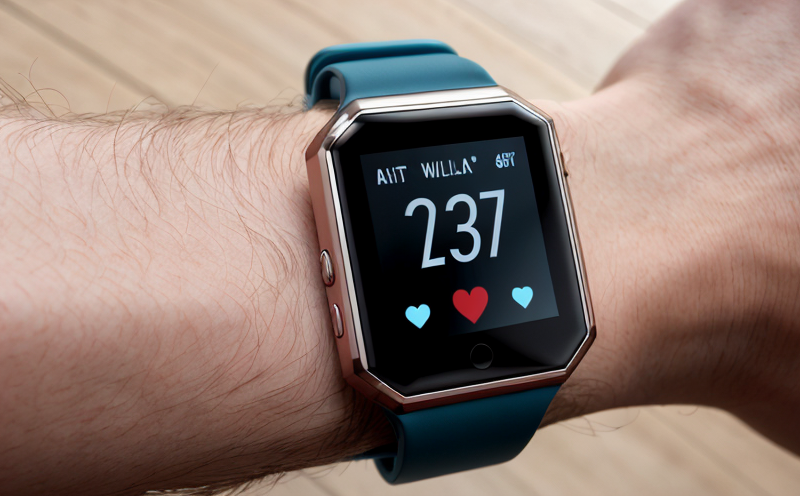IEC 60601-1-2 EMC Testing for Wearable Devices
The International Electrotechnical Commission (IEC) standard IEC 60601-1-2 is a cornerstone in the regulatory framework for ensuring that medical devices, including wearable and digital health devices, meet stringent electromagnetic compatibility (EMC) requirements. This test evaluates whether these devices can function correctly under the expected electromagnetic environment without causing harmful interference to other electronic equipment.
The primary goal of IEC 60601-1-2 is to protect patients, healthcare personnel, and other medical device users from potential hazards due to electromagnetic interference (EMI). Compliance with this standard is crucial for manufacturers as it ensures that the devices can be safely used in a variety of environments without causing or being affected by electromagnetic disturbances. This section will delve into the specifics of testing procedures, acceptance criteria, and how compliance impacts market entry.
The test involves two main parts: emission tests (to ensure the device does not emit excessive EMI) and immunity tests (to verify that the device can operate correctly in an environment with interference). For wearable devices, this means ensuring that the device remains functional even when subjected to various electromagnetic environments such as those found in hospital settings.
The process starts with a thorough understanding of the device's intended use and the potential electromagnetic environments it may encounter. This includes considering factors like patient proximity, ambient noise levels, and the presence of other medical devices. Once these factors are identified, appropriate test scenarios can be designed to simulate real-world conditions accurately.
During emission tests, instruments such as spectrum analyzers measure the emitted radio frequency (RF) signals from the device. The results are compared against specified limits defined by IEC 60601-1-2. If emissions exceed these limits, it could indicate that the device is likely to cause interference with other nearby devices.
Immunity tests, on the other hand, involve exposing the device to various types of electromagnetic disturbances and observing its performance. Common test methods include RF field exposure, conducted disturbance injection, and radiated disturbance injection. The aim here is to ensure that the wearable or digital health device can continue operating correctly despite these disturbances.
Acceptance criteria for IEC 60601-1-2 testing are stringent but necessary to guarantee product safety and efficacy in a wide range of applications. Compliance with this standard ensures that healthcare professionals, patients, and other stakeholders have confidence in the reliability and safety of medical devices.
The process is not only about meeting regulatory requirements but also enhancing brand reputation and market competitiveness by ensuring high-quality products. By adhering to these standards, manufacturers demonstrate their commitment to patient safety and healthcare innovation.
Benefits
- Increased Product Reliability: Ensures that the device functions correctly in various electromagnetic environments.
- Enhanced Patient Safety: Prevents potential harm from interference caused by the device or other devices.
- Regulatory Compliance: Meets international safety and performance standards, facilitating market entry into different regions.
- Better Brand Reputation: Demonstrates commitment to quality and patient safety, enhancing trust among healthcare providers and consumers.
The benefits of IEC 60601-1-2 testing extend beyond regulatory compliance; they contribute significantly to the overall success of a medical device. By ensuring that devices meet these stringent standards, manufacturers can build stronger relationships with healthcare institutions and patients, ultimately leading to increased market share.
Why Choose This Test
Selecting IEC 60601-1-2 EMC testing is a strategic decision for medical device manufacturers. Here are some key reasons why this test stands out:
- Global Recognition: Adherence to international standards like IEC 60601-1-2 ensures that your product meets the highest safety and performance benchmarks.
- Enhanced Product Quality: The rigorous testing process helps identify potential issues early in the development cycle, leading to higher quality products.
- Market Access: Compliance with these standards opens doors to international markets, where regulatory requirements can vary widely.
- Patient Confidence: Demonstrating adherence to such stringent safety and performance standards builds trust among healthcare professionals and patients.
In today's competitive market, choosing IEC 60601-1-2 testing is not just a requirement—it’s a smart business decision that can set your product apart from competitors. It ensures that your device meets the highest safety and performance standards, thereby enhancing its reputation in the healthcare industry.
Competitive Advantage and Market Impact
- Regulatory Compliance: Ensuring compliance with IEC 60601-1-2 is a critical step towards gaining regulatory approval, which can significantly speed up product launch timelines.
- Market Differentiation: By exceeding the basic requirements of this standard, manufacturers can differentiate their products in crowded markets. This is especially true for wearable devices where competition is fierce.
- Innovation Facilitation: The stringent testing process encourages innovation by pushing developers to improve product design and functionality under challenging conditions.
The impact on the market cannot be overstated. By choosing IEC 60601-1-2 testing, manufacturers are not only ensuring compliance but also positioning themselves as leaders in safety and performance. This strategic move can lead to increased sales, better brand loyalty, and greater market penetration.





